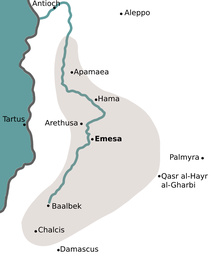Sampsigeramids
The Sampsigeramids were a Roman client dynasty that started in the 1st century BC. Is attested as the ruling house of the city of Emesa (today Homs) and is documented as such there until the 1970s. An early member of the family could also have been a certain Iamblichos, who in the mid-140s BC The young Seleucid king Antiochus VI. lived in Arethusa (now Rastan ) for some time.
The name of the dynasty is derived from Sampsigeramos I, the first detectable family member in Emesa. The name Sampsigeramos ( Greek Σαµψιγέραµος) or Samsigeramos (Σαµσιγέραµος) is an Arabic or Aramaic name ( šmšgrm ) and means "šamaš has decided".
Members
The tomb of Sampsigeramos was built in 78/79 AD by Gaius Iulius Sampsigeramos, probably a member of the dynasty.
literature
- Carl Watzinger: The tomb of Samsigeramos from Emesa. In: Konsthistoriska Sällskapets publication. Year 1923, pp. 18–43.
- Henri Seyrig: Antiquités Syriennes 53: Antiquités de la Nécropole d'Émèse (1 re partie). In: Syria. Volume 29, Numbers 3-4, 1952, pp. 204-250 ( online ).
- Richard D. Sullivan: The Dynasty of Emesa. In: Hildegard Temporini , Wolfgang Haase (Hrsg.): Rise and decline of the Roman world . Volume II 8, Walter de Gruyter, Berlin 1977, pp. 198-219.
- Andreas Kropp: Earrings, Nefesh and Opus Reticulatum : Self-Representation of the Royal House of Emesa in the First Century AD . In: Ted Kaizer, Margherita Facella (Ed.): Kingdoms and Principalities in the Roman Near East (= Oriens et Occidens. Volume 19). Franz Steiner, Stuttgart 2010, ISBN 978-3-515-09715-4 , pp. 199-216 ( online ).
- Michaela Konrad : Emesa between clientele and province. Identity and identity change of a local princely dynasty in the mirror of the archaeological sources (= Orient-Archäologie. Volume 34). VML Leidorf, Rahden (Westphalia) 2014, ISBN 978-3-89646-664-8 .
Individual evidence
- ↑ For the name forms attested in the ancient sources see Felix Staehelin : Sampsigeramos. In: Paulys Realencyclopadie der classischen Antiquity Science (RE). Volume IA, 2, Stuttgart 1920, Col. 2226.
- ^ Gabriele Ziethen: Names like stars. To the Uranius graffito from Linz. In: Historisches Jahrbuch der Stadt Linz 2001, pp. 395–410, here p. 404 ( PDF ) with further literature on the name.

